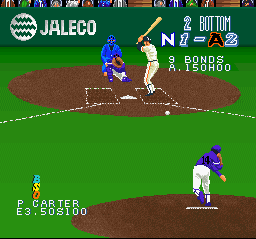Overview
Super Bases Loaded in the first Super Nintendo entry in Jaleco's Bases Loaded series of baseball games, known in Japan as Super Professional Baseball. The game uses an unusual perspective for its batting/pitching, and employs far more realistic-looking athletes. This is counter to Namco's more famous Super Famista/Super Batter Up, which uses super-deformed characters.
Super Bases Loaded was followed by the Japan-exclusive Super Professional Baseball II. The second Super Bases Loaded, Super Bases Loaded 2, is actually a localization of Jaleco's later game Super 3D Baseball.
Gameplay
Super Bases Loaded plays similarly to actual American baseball, and is housed under most of the same rule sets: one team hits while the other fields and pitches; four balls pitched outside the invisible hit-box constitutes a free base, while three suitable pitches results in a strike out. While many advanced rules are also in effect (such as bunt-strike outs) others - balks, infield "fly-outs," foul-pole home runs - are curiously absent. Additionally, players controlling the pitcher can deliberately pitch at players, resulting in neither the batter nor pitcher being penalized beyond an extra base. When players swing, however, their hit-boxes are eliminated, allowing pitchers to throw balls through the batter, and still receive a strike. There is a ten-run mercy rule limit in effect at all times, and a game can only last for up to 23 innings.
 Each pitcher and batter has a unique stance.
Each pitcher and batter has a unique stance. Unlike previous entries that largely randomize hits, the game employs a variable physics engine that accounts for timing, bat, and pitch speed, as well as completion of swing, and registered statistics for both the batter and pitcher. Pitchers' speed and accuracy stagnate after every pitch, allowing pitch speeds to range from above 100 mph to below 60. Gravity involving the ball, however, is largely unrealistic, as balls can remain up in the air for periods lasting over 10 seconds. Bunts, especially, can be nearly impossible to execute without being caught. Likewise, lateral ball travel is also markedly sluggish.
Baseball can only be played in Bases Loaded Stadium, under the same conditions. The stadium walls are riddled with fake advertisements parodying real-world counterparts. The audience will cheer after every play, with the same enthusiasm, for both teams.
The game includes a robust single-player campaign, challenging players to play a "perfect season," or a season composed of eleven perfect games free of runs, hits, and errors.
Roster
Despite the North American release sporting Ryne Sandberg's endorsement, Super Bases Loaded contains a roster of twelve fictional teams, each with fictional players and statistics. Players can also choose to edit a team together (literally as "Team Edit"). Individual roster statistics can be adjusted to build near-perfect players.
Technical
- Runs at 640 x 480 resolution; supports limited Mode-7 3D
- Up to two players; can play itself automatically be selecting "Watch" mode
- The soundtrack consists of ten themes, two of which alternate during play
- There are five voiced sound clips: "Strike", "Ball", "Out", "Safe", and "Home Run"
- Wild pitches can occasionally cause an overflow on the catcher's y-coordinate, resulting in his glove phasing through the ground and reappearing above his head
- Players never drop passes from teammates, and every throw is perfectly on-target
- Swings can be stopped before completion; check-swings are properly recorded, and there are hidden animations for manipulating the D-Pad while holding the bat out
- The pitch speed ranges from 47 to 110 MPH. Neither have even been thrown in an actual MLB game
- Pitch speed is often inconsistent with the actual speed of the ball
- The baseball that enters the screen in the intro can be controlled via controller slot 2
- There are no transitory animations for catching the ball, which makes it appear to strike the player's back
- If a swing is executed after the ball enters the strike-zone, it will not register, and any called ball will not be regarded as a strike
- The home crowd cheers equally for both teams
- Each game is capped at 20 innings
- A knuckleball can be enabled by quickly cycling the D-Pad
- The "infield-fly" rule is not enforced, meaning fly balls that fails to reach the outfield can be deliberately dropped to create a force out at either third base (if there are runners on first and second base) or home (if the bases are loaded).
Log in to comment